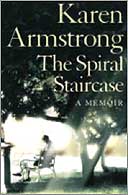
The Spiral Staircase
by Karen Armstrong
342pp, HarperCollins, £20
"I wanted to find God." So Karen Armstrong announces the quest that took her into a convent at the age of 17. Soon afterwards, the Second Vatican Council convened. Its desire to let in modernity upset the rigid, often outdated practices followed by many religious orders. Armstrong is convinced she experienced the traditional regime at its worst. After seven years and a minor breakdown, she applied for a dispensation from her vows and returned to the world, "obscurely broken and damaged". Time and again in this autobiography she confronts failure and despair.
Yet, by the end, she has become an impressive phenomenon: a self-taught theologian and author of a string of books, among them A History of God, which strides through four millennia and across three faiths - Judaism, Christianity and Islam - with contagious gusto and immense learning. Her research sensitised her to the debates surrounding the fatwa on Salman Rushdie. This she abhorred, but she also noted how the counter-attack by Rushdie's champions quickly segued into a denunciation of Islam itself. In response, she took time out from A History of God to write, for a western audience, a life of the Prophet Mohammed, which she has since followed with a short history of Islam. Her readership widened further with her life of the Buddha.
But it's her own spiritual journey which she traces here. And the chief relationship is with a being who is conspicuous by his absence. This she first noticed at the convent, where she could not admit "the shameful secret that, unlike the other sisters, I could not pray". At the time she blamed it on herself, on her scattered mind and heart and lack of inner silence. But, even then, she occasionally wondered if God wasn't rather like the emperor's new clothes: nobody dared admit that he wasn't there.
The convent years are briefly summarised, as a full account of them has been given in Through the Narrow Gate. This was Armstrong's first book and, encouraged by its success, she wrote a sequel, Beginning the World. It charts a difficult rite of passage, for she moved, very ill-equipped, into a wholly secular existence, joining the exuberantly rebellious, experimental student life of the late 1960s. In addition she was clearly unwell: she suffered black-outs and hallucinations. It was many years before a doctor informed her that these are symptoms of a certain kind of epilepsy.
It is not just her accounts of ill-health that make Beginning the World a painful and uneasy book: in places it seems inauthentic. And now we learn why. The publishers wanted her to make it as dramatic and accessible as possible; they ruled out ruminative matter, literary or theological; and the author comes across less as an intellectual than as a foot-off-the-ground relative of Stevie Smith at her most gossipy and self-absorbed.
Nowadays, Armstrong abhors its "hearty, boisterous and relentlessly extrovert tone". So here she tries again. The tale is sharpened, made more resonant, and tidied up: she intensifies her affectionate portrait of the family with whom she lodges free of charge, in return for help with their brain-damaged son; she exposes in more detail the pain caused by Oxford's rejection of her doctoral thesis; and she expunges from the account her relations with men, on the grounds that none developed into anything significant. She is, she claims, not only a failed nun and failed academic, but also a failed heterosexual. Perhaps her convent conditioning is a cause, or the fact that at a time when people usually mate, she was engaged in a private battle with undiagnosed illness. She considers both possibilities, but also wonders if her solitariness is due to some deeper imperative.
One thing is certain: she totally flunked on God. Her disaffection began at Oxford, where the new vernacular mass dismayed her. "It suggested that God was well disposed towards us, and could be approached in a casual, confident spirit, as though he was a congenial boss." This had never been her experience, and after moving to London, where she worked as a tutorial fellow at Bedford College, then taught English in a south London girls' school, she dropped him completely. Later still, while working on a television film on St Paul, in "the robust secularist atmosphere of Channel 4", she revelled in iconoclasm and found it cathartic. Nevertheless, it was while making this film and visiting Jerusalem that her interest in Judaism and Islam took root.
Armstrong owes the title of this book to Helen Gardner, who, in a lecture on Eliot's "Ash Wednesday" sequence, pointed out that the spiral staircase becomes a symbol for spiritual advance. As she began to immerse herself in sacred writings, Armstrong recognised that "the very absence I felt so acutely was paradoxically a presence in my life". Those seemingly arbitrary revolutions in her own progress had finally returned her to what she had been seeking all those years ago, "when I had packed my suitcase, entered my convent and set off to find God".
· Frances Spalding's Gwen Raverat: Friends, Family and Affections is published by Pimlico.

